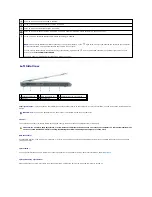
subwoofer
—
Produces a broader bass output than is provided by the speakers.
battery charge gauge
—
Provides information on the battery charge status. For more information, see
Checking the Battery Charge
.
battery-bay latch release
—
Releases the battery from the battery bay. For more information, see
Replacing the Battery
.
battery
—
When a battery is installed, you can use the computer without connecting the computer to an electrical outlet. For more information, see
Using a Battery
.
cover for optional internal card with Bluetooth
®
wireless technology
—
For more information, see the documentation that came with your card. To quickly
enable or disable all wireless devices, press <Fn><F2>.
hard drive
—
Stores software and data. For more information, see
Hard Drive
. The size displayed for your hard drive in Windows Explorer is the capacity of the
drive before any operating system or programs are installed.
air vent
—
The computer uses fan(s) to create airflow through the vent(s), which prevents the computer from overheating.
Mini-Card/modem cover
—
Covers the compartment that contains the Mini-Card and the modem. For more information, see
Mini-Card
and
Modem
.
memory module cover
—
Covers the compartment that contains the memory modules. For more information, see
Memory
.
optical-drive locking screw
—
Secures the optical drive in the optical drive bay. For more information, see
Optical Drive
.
1 subwoofer
5 cover for optional internal card with
Bluetooth
®
wireless technology
9
docking connector
2 battery charge
gauge
6 hard drive
10 memory module
cover
3 battery-bay latch
release
7 air vent
11 air vent
4 battery
8 Mini-Card/modem cover
12 optical-drive
locking screw
CAUTION:
Do not block, push objects into, or allow dust to accumulate in the air vents. Do not store your computer in a low-airflow environment,
such as a closed briefcase, while it is running. Restricting the airflow can damage the computer or cause a fire.
Summary of Contents for XPS M1710
Page 34: ...Back to Contents Page ...










































